Business Law Assignment - Business Organizations & Legal Solutions
VerifiedAdded on 2020/10/05
|14
|4102
|399
Report
AI Summary
This business law assignment examines various sources of law, including Parliament/statute, judiciary/common law, and European Union directives, detailing their roles and applications within the UK legal system. The report explores the roles of the government in law-making, encompassing executive, legislative, and judicial functions, along with the processes of enacting legislation. It then illustrates the impact of company law, employment law, and contract law on businesses through specific examples. Different types of business organizations, such as sole proprietorships, partnerships, and limited companies, are analyzed, including their management and funding. Finally, the assignment recommends legal solutions for resolving business disputes, covering aspects from incorporation to dispute resolution strategies, providing a comprehensive overview of essential legal considerations for businesses.
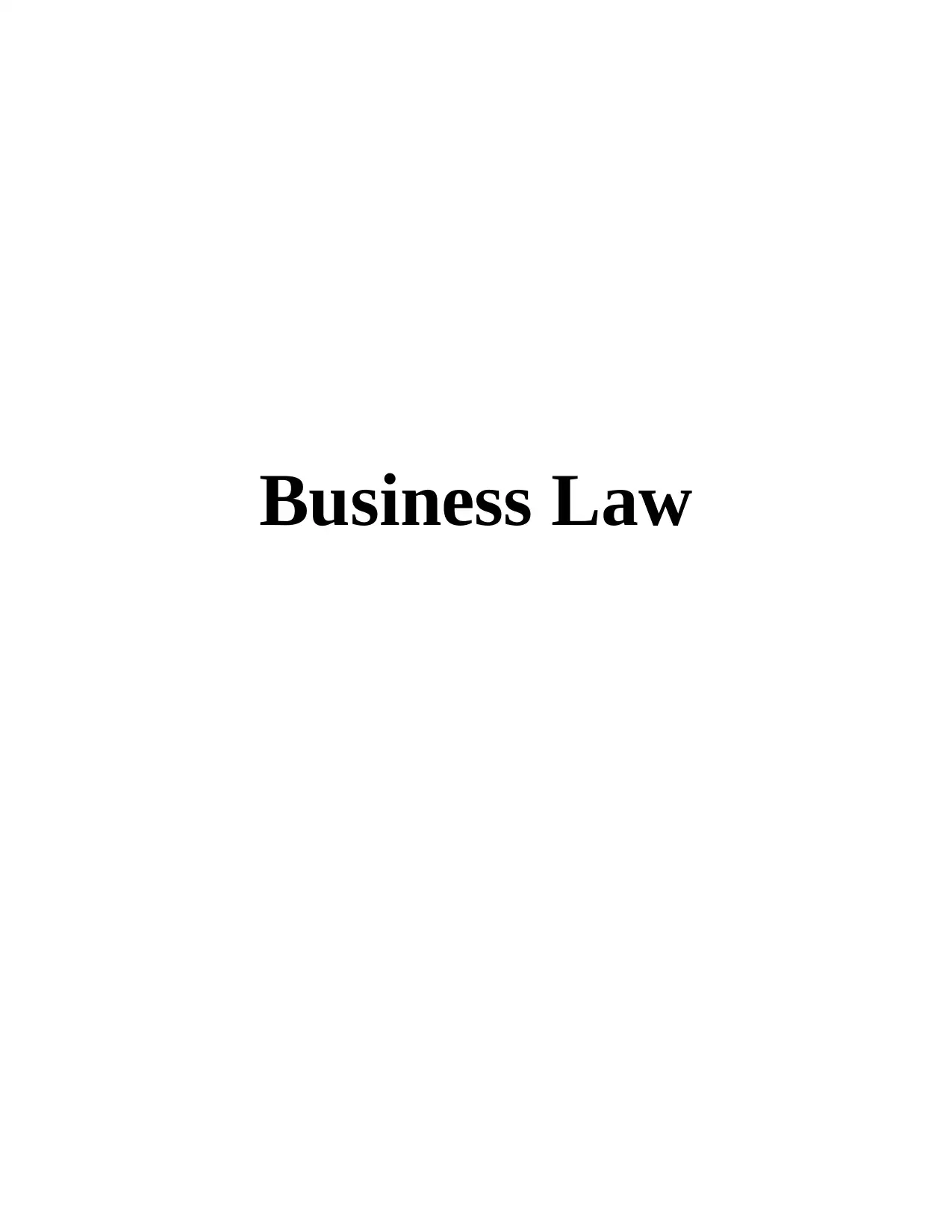
Business Law
Paraphrase This Document
Need a fresh take? Get an instant paraphrase of this document with our AI Paraphraser

Table of Contents
INTRODUCTION...........................................................................................................................3
TASK 1............................................................................................................................................3
P1. Explain different sources of law...........................................................................................3
P2. Explain role of government in law making and application of common and statutory law
in justice courts...........................................................................................................................4
TASK 2............................................................................................................................................6
P3. Using specific examples illustrate the potential impact of company, employment and
contract law on a business...........................................................................................................6
TASK 3............................................................................................................................................7
P4. Explore different types of business organizations that are legally formed...........................7
P5. Explain how business organizations are managed and funded.............................................8
TASK 4............................................................................................................................................9
P6. Recommend legal solutions for resolving range of disputes using examples......................9
CONCLUSION..............................................................................................................................10
REFERENCES..............................................................................................................................11
INTRODUCTION...........................................................................................................................3
TASK 1............................................................................................................................................3
P1. Explain different sources of law...........................................................................................3
P2. Explain role of government in law making and application of common and statutory law
in justice courts...........................................................................................................................4
TASK 2............................................................................................................................................6
P3. Using specific examples illustrate the potential impact of company, employment and
contract law on a business...........................................................................................................6
TASK 3............................................................................................................................................7
P4. Explore different types of business organizations that are legally formed...........................7
P5. Explain how business organizations are managed and funded.............................................8
TASK 4............................................................................................................................................9
P6. Recommend legal solutions for resolving range of disputes using examples......................9
CONCLUSION..............................................................................................................................10
REFERENCES..............................................................................................................................11
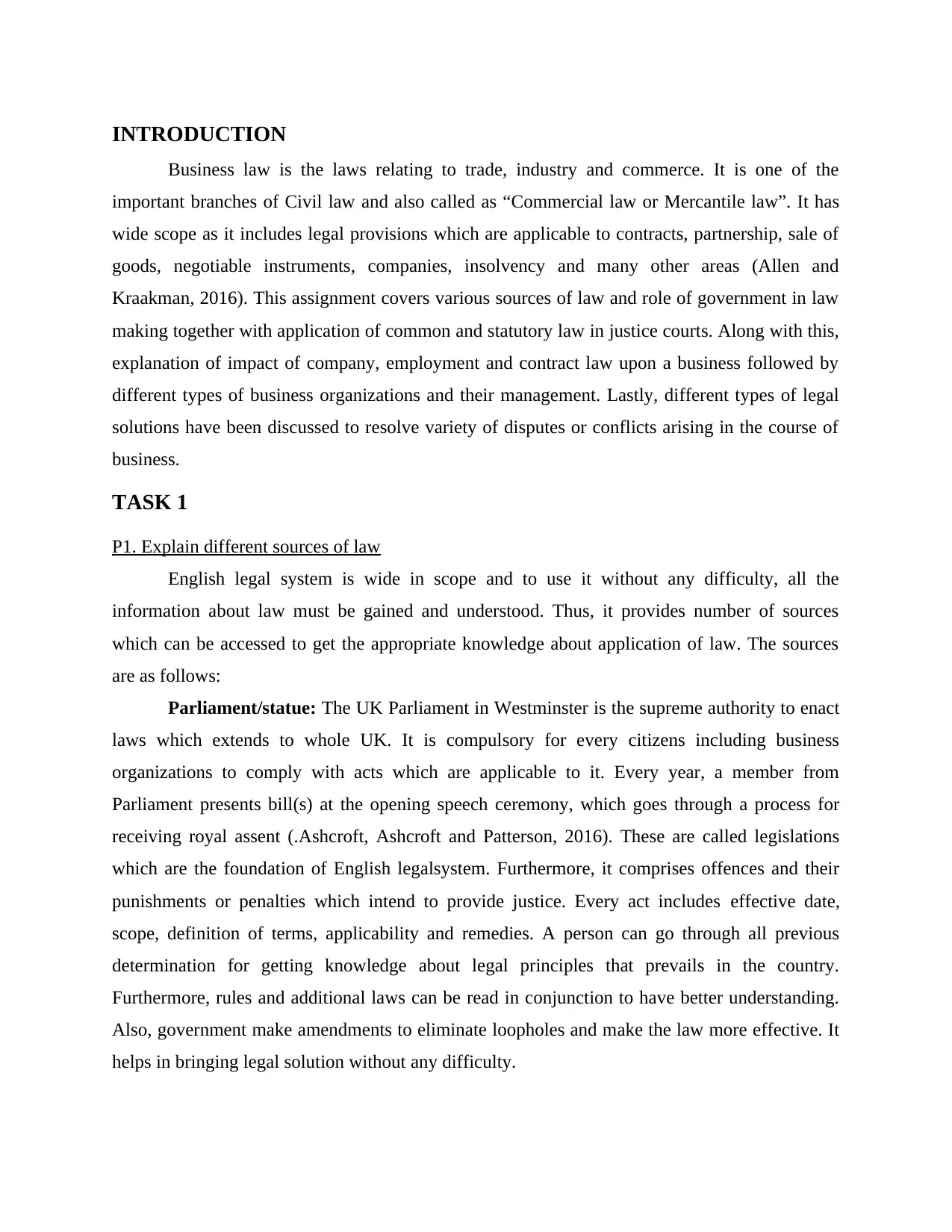
INTRODUCTION
Business law is the laws relating to trade, industry and commerce. It is one of the
important branches of Civil law and also called as “Commercial law or Mercantile law”. It has
wide scope as it includes legal provisions which are applicable to contracts, partnership, sale of
goods, negotiable instruments, companies, insolvency and many other areas (Allen and
Kraakman, 2016). This assignment covers various sources of law and role of government in law
making together with application of common and statutory law in justice courts. Along with this,
explanation of impact of company, employment and contract law upon a business followed by
different types of business organizations and their management. Lastly, different types of legal
solutions have been discussed to resolve variety of disputes or conflicts arising in the course of
business.
TASK 1
P1. Explain different sources of law
English legal system is wide in scope and to use it without any difficulty, all the
information about law must be gained and understood. Thus, it provides number of sources
which can be accessed to get the appropriate knowledge about application of law. The sources
are as follows:
Parliament/statue: The UK Parliament in Westminster is the supreme authority to enact
laws which extends to whole UK. It is compulsory for every citizens including business
organizations to comply with acts which are applicable to it. Every year, a member from
Parliament presents bill(s) at the opening speech ceremony, which goes through a process for
receiving royal assent (.Ashcroft, Ashcroft and Patterson, 2016). These are called legislations
which are the foundation of English legalsystem. Furthermore, it comprises offences and their
punishments or penalties which intend to provide justice. Every act includes effective date,
scope, definition of terms, applicability and remedies. A person can go through all previous
determination for getting knowledge about legal principles that prevails in the country.
Furthermore, rules and additional laws can be read in conjunction to have better understanding.
Also, government make amendments to eliminate loopholes and make the law more effective. It
helps in bringing legal solution without any difficulty.
Business law is the laws relating to trade, industry and commerce. It is one of the
important branches of Civil law and also called as “Commercial law or Mercantile law”. It has
wide scope as it includes legal provisions which are applicable to contracts, partnership, sale of
goods, negotiable instruments, companies, insolvency and many other areas (Allen and
Kraakman, 2016). This assignment covers various sources of law and role of government in law
making together with application of common and statutory law in justice courts. Along with this,
explanation of impact of company, employment and contract law upon a business followed by
different types of business organizations and their management. Lastly, different types of legal
solutions have been discussed to resolve variety of disputes or conflicts arising in the course of
business.
TASK 1
P1. Explain different sources of law
English legal system is wide in scope and to use it without any difficulty, all the
information about law must be gained and understood. Thus, it provides number of sources
which can be accessed to get the appropriate knowledge about application of law. The sources
are as follows:
Parliament/statue: The UK Parliament in Westminster is the supreme authority to enact
laws which extends to whole UK. It is compulsory for every citizens including business
organizations to comply with acts which are applicable to it. Every year, a member from
Parliament presents bill(s) at the opening speech ceremony, which goes through a process for
receiving royal assent (.Ashcroft, Ashcroft and Patterson, 2016). These are called legislations
which are the foundation of English legalsystem. Furthermore, it comprises offences and their
punishments or penalties which intend to provide justice. Every act includes effective date,
scope, definition of terms, applicability and remedies. A person can go through all previous
determination for getting knowledge about legal principles that prevails in the country.
Furthermore, rules and additional laws can be read in conjunction to have better understanding.
Also, government make amendments to eliminate loopholes and make the law more effective. It
helps in bringing legal solution without any difficulty.
⊘ This is a preview!⊘
Do you want full access?
Subscribe today to unlock all pages.

Trusted by 1+ million students worldwide
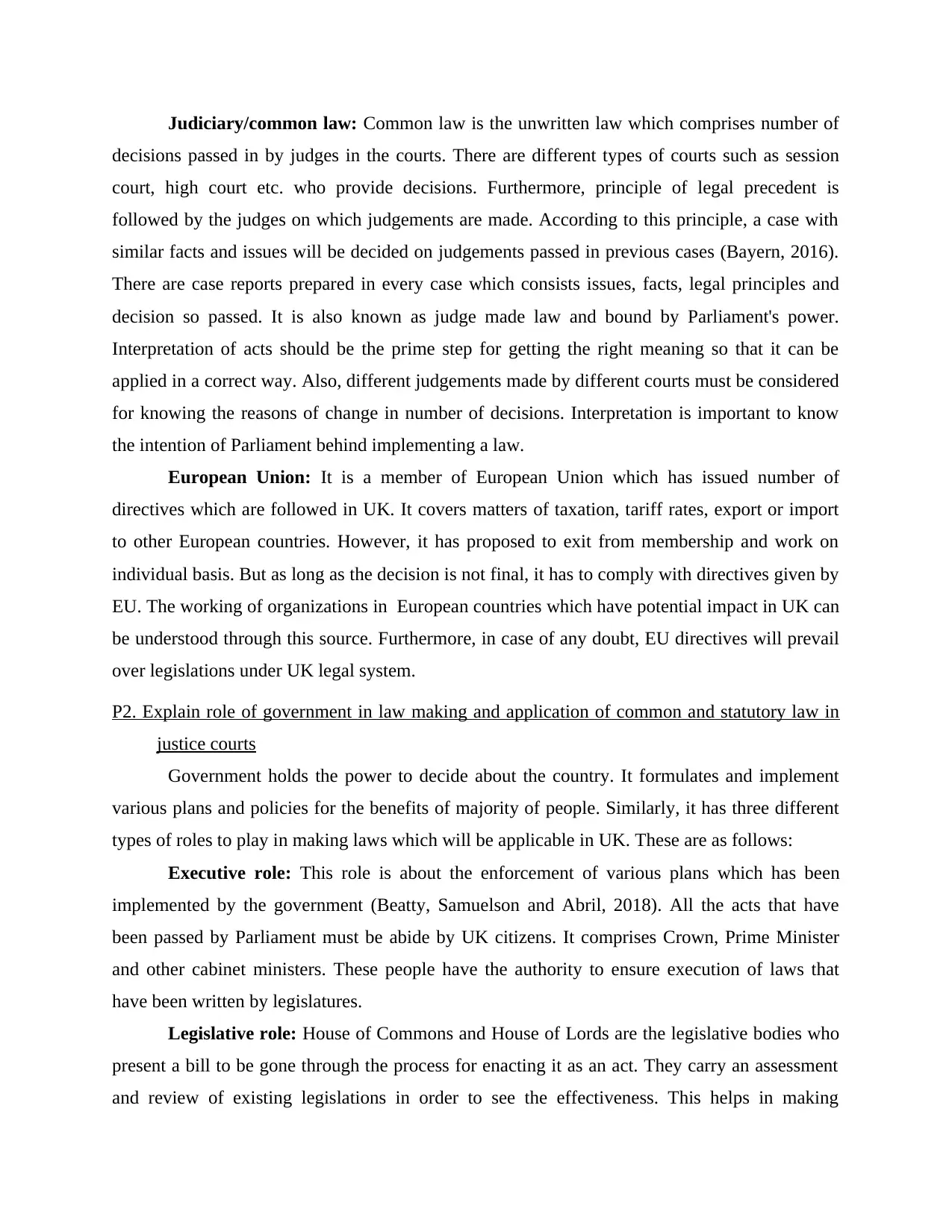
Judiciary/common law: Common law is the unwritten law which comprises number of
decisions passed in by judges in the courts. There are different types of courts such as session
court, high court etc. who provide decisions. Furthermore, principle of legal precedent is
followed by the judges on which judgements are made. According to this principle, a case with
similar facts and issues will be decided on judgements passed in previous cases (Bayern, 2016).
There are case reports prepared in every case which consists issues, facts, legal principles and
decision so passed. It is also known as judge made law and bound by Parliament's power.
Interpretation of acts should be the prime step for getting the right meaning so that it can be
applied in a correct way. Also, different judgements made by different courts must be considered
for knowing the reasons of change in number of decisions. Interpretation is important to know
the intention of Parliament behind implementing a law.
European Union: It is a member of European Union which has issued number of
directives which are followed in UK. It covers matters of taxation, tariff rates, export or import
to other European countries. However, it has proposed to exit from membership and work on
individual basis. But as long as the decision is not final, it has to comply with directives given by
EU. The working of organizations in European countries which have potential impact in UK can
be understood through this source. Furthermore, in case of any doubt, EU directives will prevail
over legislations under UK legal system.
P2. Explain role of government in law making and application of common and statutory law in
justice courts
Government holds the power to decide about the country. It formulates and implement
various plans and policies for the benefits of majority of people. Similarly, it has three different
types of roles to play in making laws which will be applicable in UK. These are as follows:
Executive role: This role is about the enforcement of various plans which has been
implemented by the government (Beatty, Samuelson and Abril, 2018). All the acts that have
been passed by Parliament must be abide by UK citizens. It comprises Crown, Prime Minister
and other cabinet ministers. These people have the authority to ensure execution of laws that
have been written by legislatures.
Legislative role: House of Commons and House of Lords are the legislative bodies who
present a bill to be gone through the process for enacting it as an act. They carry an assessment
and review of existing legislations in order to see the effectiveness. This helps in making
decisions passed in by judges in the courts. There are different types of courts such as session
court, high court etc. who provide decisions. Furthermore, principle of legal precedent is
followed by the judges on which judgements are made. According to this principle, a case with
similar facts and issues will be decided on judgements passed in previous cases (Bayern, 2016).
There are case reports prepared in every case which consists issues, facts, legal principles and
decision so passed. It is also known as judge made law and bound by Parliament's power.
Interpretation of acts should be the prime step for getting the right meaning so that it can be
applied in a correct way. Also, different judgements made by different courts must be considered
for knowing the reasons of change in number of decisions. Interpretation is important to know
the intention of Parliament behind implementing a law.
European Union: It is a member of European Union which has issued number of
directives which are followed in UK. It covers matters of taxation, tariff rates, export or import
to other European countries. However, it has proposed to exit from membership and work on
individual basis. But as long as the decision is not final, it has to comply with directives given by
EU. The working of organizations in European countries which have potential impact in UK can
be understood through this source. Furthermore, in case of any doubt, EU directives will prevail
over legislations under UK legal system.
P2. Explain role of government in law making and application of common and statutory law in
justice courts
Government holds the power to decide about the country. It formulates and implement
various plans and policies for the benefits of majority of people. Similarly, it has three different
types of roles to play in making laws which will be applicable in UK. These are as follows:
Executive role: This role is about the enforcement of various plans which has been
implemented by the government (Beatty, Samuelson and Abril, 2018). All the acts that have
been passed by Parliament must be abide by UK citizens. It comprises Crown, Prime Minister
and other cabinet ministers. These people have the authority to ensure execution of laws that
have been written by legislatures.
Legislative role: House of Commons and House of Lords are the legislative bodies who
present a bill to be gone through the process for enacting it as an act. They carry an assessment
and review of existing legislations in order to see the effectiveness. This helps in making
Paraphrase This Document
Need a fresh take? Get an instant paraphrase of this document with our AI Paraphraser
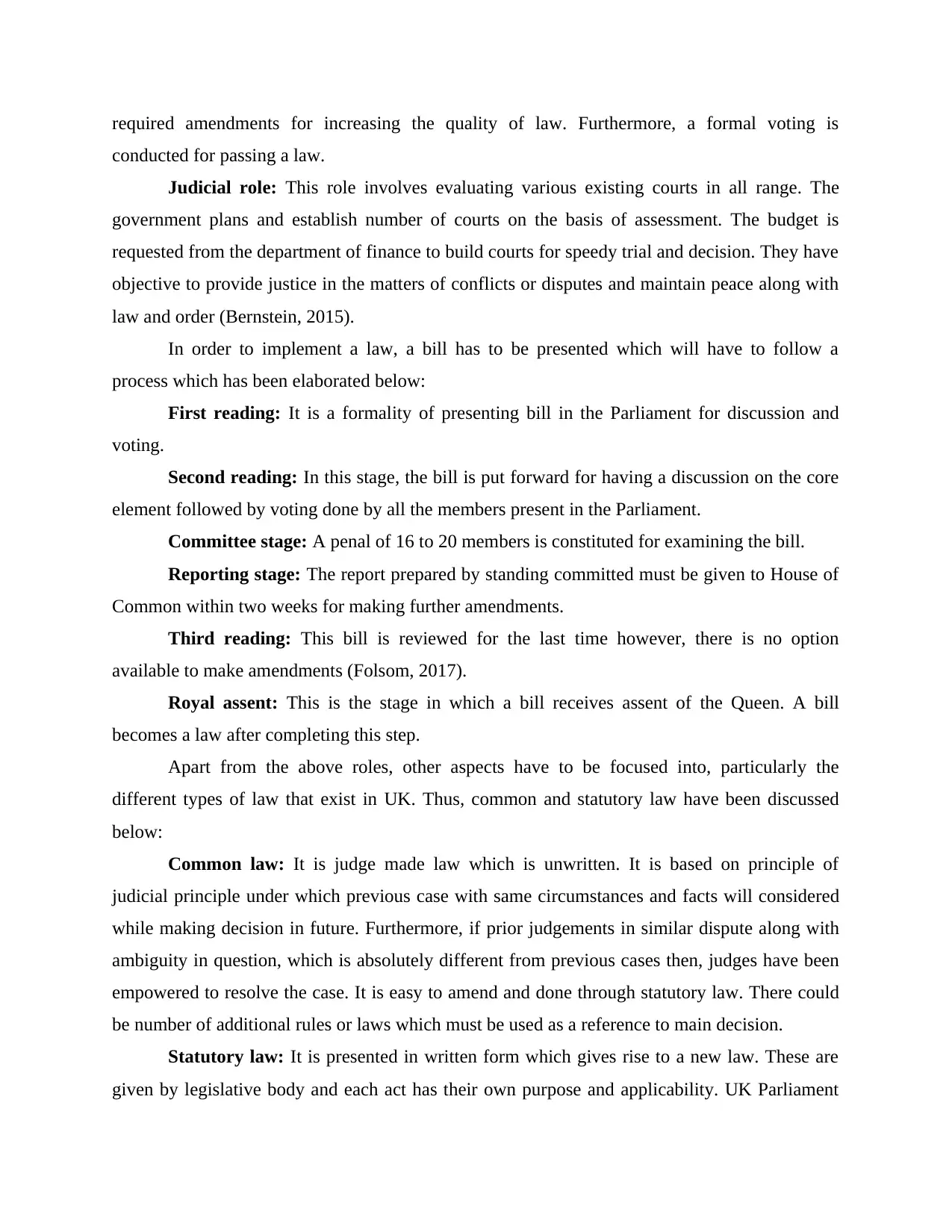
required amendments for increasing the quality of law. Furthermore, a formal voting is
conducted for passing a law.
Judicial role: This role involves evaluating various existing courts in all range. The
government plans and establish number of courts on the basis of assessment. The budget is
requested from the department of finance to build courts for speedy trial and decision. They have
objective to provide justice in the matters of conflicts or disputes and maintain peace along with
law and order (Bernstein, 2015).
In order to implement a law, a bill has to be presented which will have to follow a
process which has been elaborated below:
First reading: It is a formality of presenting bill in the Parliament for discussion and
voting.
Second reading: In this stage, the bill is put forward for having a discussion on the core
element followed by voting done by all the members present in the Parliament.
Committee stage: A penal of 16 to 20 members is constituted for examining the bill.
Reporting stage: The report prepared by standing committed must be given to House of
Common within two weeks for making further amendments.
Third reading: This bill is reviewed for the last time however, there is no option
available to make amendments (Folsom, 2017).
Royal assent: This is the stage in which a bill receives assent of the Queen. A bill
becomes a law after completing this step.
Apart from the above roles, other aspects have to be focused into, particularly the
different types of law that exist in UK. Thus, common and statutory law have been discussed
below:
Common law: It is judge made law which is unwritten. It is based on principle of
judicial principle under which previous case with same circumstances and facts will considered
while making decision in future. Furthermore, if prior judgements in similar dispute along with
ambiguity in question, which is absolutely different from previous cases then, judges have been
empowered to resolve the case. It is easy to amend and done through statutory law. There could
be number of additional rules or laws which must be used as a reference to main decision.
Statutory law: It is presented in written form which gives rise to a new law. These are
given by legislative body and each act has their own purpose and applicability. UK Parliament
conducted for passing a law.
Judicial role: This role involves evaluating various existing courts in all range. The
government plans and establish number of courts on the basis of assessment. The budget is
requested from the department of finance to build courts for speedy trial and decision. They have
objective to provide justice in the matters of conflicts or disputes and maintain peace along with
law and order (Bernstein, 2015).
In order to implement a law, a bill has to be presented which will have to follow a
process which has been elaborated below:
First reading: It is a formality of presenting bill in the Parliament for discussion and
voting.
Second reading: In this stage, the bill is put forward for having a discussion on the core
element followed by voting done by all the members present in the Parliament.
Committee stage: A penal of 16 to 20 members is constituted for examining the bill.
Reporting stage: The report prepared by standing committed must be given to House of
Common within two weeks for making further amendments.
Third reading: This bill is reviewed for the last time however, there is no option
available to make amendments (Folsom, 2017).
Royal assent: This is the stage in which a bill receives assent of the Queen. A bill
becomes a law after completing this step.
Apart from the above roles, other aspects have to be focused into, particularly the
different types of law that exist in UK. Thus, common and statutory law have been discussed
below:
Common law: It is judge made law which is unwritten. It is based on principle of
judicial principle under which previous case with same circumstances and facts will considered
while making decision in future. Furthermore, if prior judgements in similar dispute along with
ambiguity in question, which is absolutely different from previous cases then, judges have been
empowered to resolve the case. It is easy to amend and done through statutory law. There could
be number of additional rules or laws which must be used as a reference to main decision.
Statutory law: It is presented in written form which gives rise to a new law. These are
given by legislative body and each act has their own purpose and applicability. UK Parliament
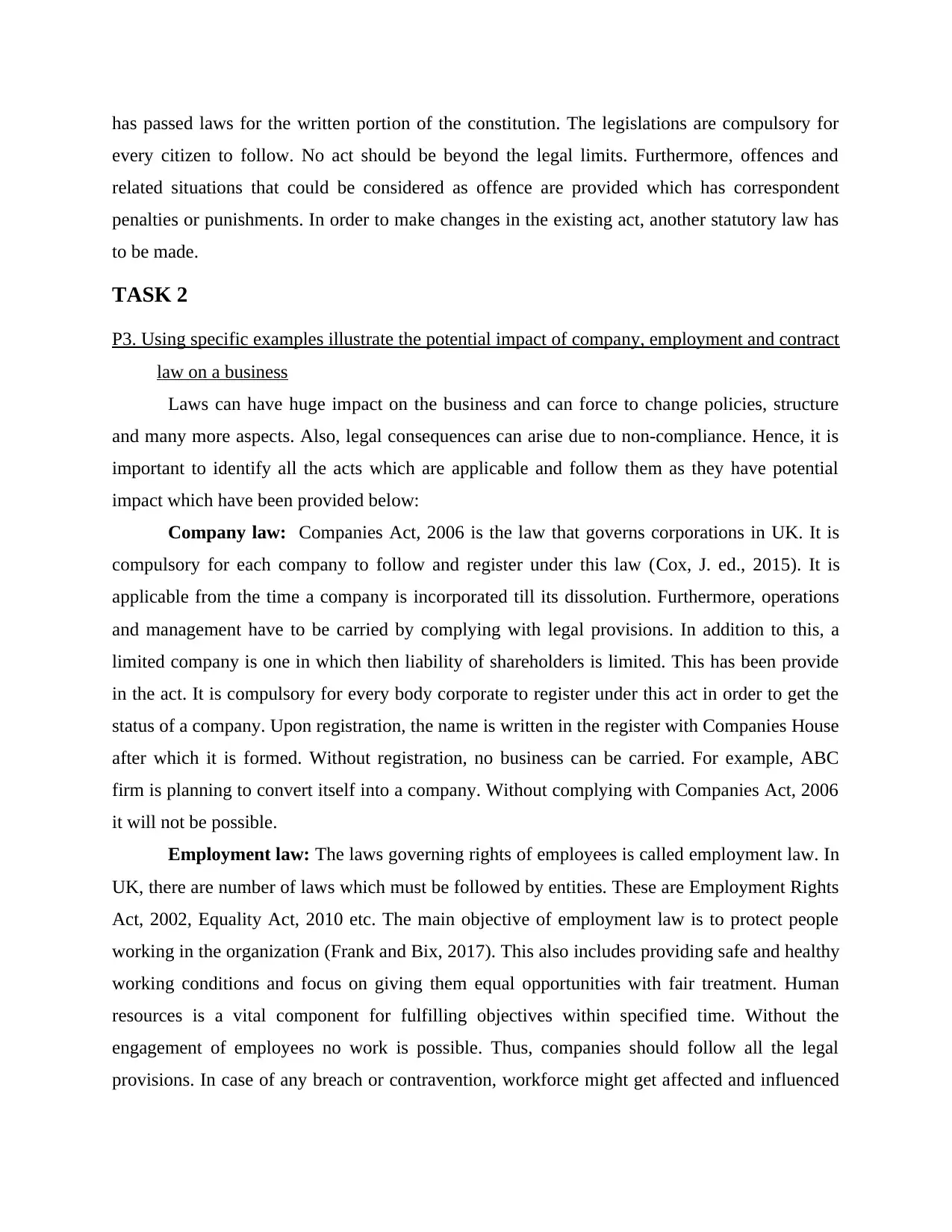
has passed laws for the written portion of the constitution. The legislations are compulsory for
every citizen to follow. No act should be beyond the legal limits. Furthermore, offences and
related situations that could be considered as offence are provided which has correspondent
penalties or punishments. In order to make changes in the existing act, another statutory law has
to be made.
TASK 2
P3. Using specific examples illustrate the potential impact of company, employment and contract
law on a business
Laws can have huge impact on the business and can force to change policies, structure
and many more aspects. Also, legal consequences can arise due to non-compliance. Hence, it is
important to identify all the acts which are applicable and follow them as they have potential
impact which have been provided below:
Company law: Companies Act, 2006 is the law that governs corporations in UK. It is
compulsory for each company to follow and register under this law (Cox, J. ed., 2015). It is
applicable from the time a company is incorporated till its dissolution. Furthermore, operations
and management have to be carried by complying with legal provisions. In addition to this, a
limited company is one in which then liability of shareholders is limited. This has been provide
in the act. It is compulsory for every body corporate to register under this act in order to get the
status of a company. Upon registration, the name is written in the register with Companies House
after which it is formed. Without registration, no business can be carried. For example, ABC
firm is planning to convert itself into a company. Without complying with Companies Act, 2006
it will not be possible.
Employment law: The laws governing rights of employees is called employment law. In
UK, there are number of laws which must be followed by entities. These are Employment Rights
Act, 2002, Equality Act, 2010 etc. The main objective of employment law is to protect people
working in the organization (Frank and Bix, 2017). This also includes providing safe and healthy
working conditions and focus on giving them equal opportunities with fair treatment. Human
resources is a vital component for fulfilling objectives within specified time. Without the
engagement of employees no work is possible. Thus, companies should follow all the legal
provisions. In case of any breach or contravention, workforce might get affected and influenced
every citizen to follow. No act should be beyond the legal limits. Furthermore, offences and
related situations that could be considered as offence are provided which has correspondent
penalties or punishments. In order to make changes in the existing act, another statutory law has
to be made.
TASK 2
P3. Using specific examples illustrate the potential impact of company, employment and contract
law on a business
Laws can have huge impact on the business and can force to change policies, structure
and many more aspects. Also, legal consequences can arise due to non-compliance. Hence, it is
important to identify all the acts which are applicable and follow them as they have potential
impact which have been provided below:
Company law: Companies Act, 2006 is the law that governs corporations in UK. It is
compulsory for each company to follow and register under this law (Cox, J. ed., 2015). It is
applicable from the time a company is incorporated till its dissolution. Furthermore, operations
and management have to be carried by complying with legal provisions. In addition to this, a
limited company is one in which then liability of shareholders is limited. This has been provide
in the act. It is compulsory for every body corporate to register under this act in order to get the
status of a company. Upon registration, the name is written in the register with Companies House
after which it is formed. Without registration, no business can be carried. For example, ABC
firm is planning to convert itself into a company. Without complying with Companies Act, 2006
it will not be possible.
Employment law: The laws governing rights of employees is called employment law. In
UK, there are number of laws which must be followed by entities. These are Employment Rights
Act, 2002, Equality Act, 2010 etc. The main objective of employment law is to protect people
working in the organization (Frank and Bix, 2017). This also includes providing safe and healthy
working conditions and focus on giving them equal opportunities with fair treatment. Human
resources is a vital component for fulfilling objectives within specified time. Without the
engagement of employees no work is possible. Thus, companies should follow all the legal
provisions. In case of any breach or contravention, workforce might get affected and influenced
⊘ This is a preview!⊘
Do you want full access?
Subscribe today to unlock all pages.

Trusted by 1+ million students worldwide
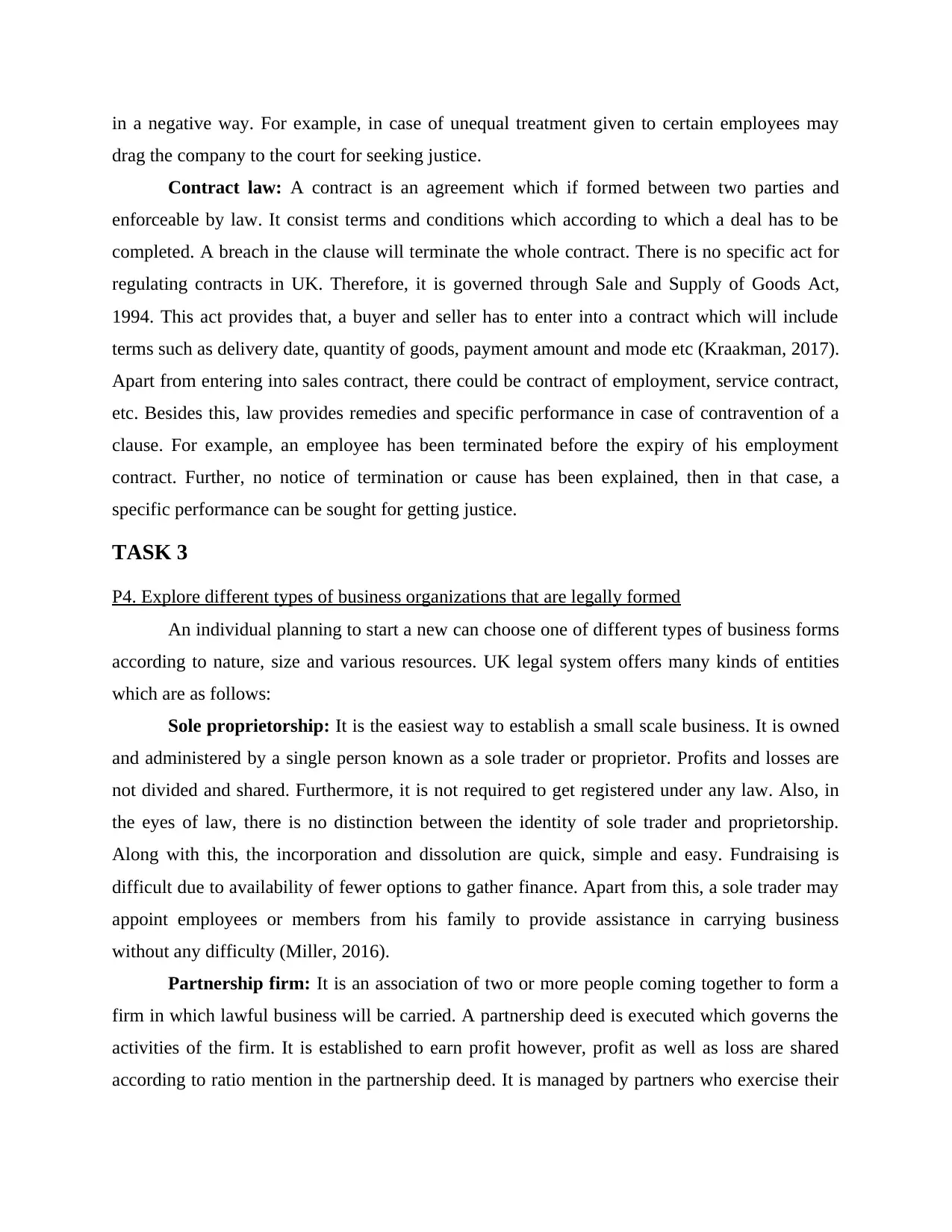
in a negative way. For example, in case of unequal treatment given to certain employees may
drag the company to the court for seeking justice.
Contract law: A contract is an agreement which if formed between two parties and
enforceable by law. It consist terms and conditions which according to which a deal has to be
completed. A breach in the clause will terminate the whole contract. There is no specific act for
regulating contracts in UK. Therefore, it is governed through Sale and Supply of Goods Act,
1994. This act provides that, a buyer and seller has to enter into a contract which will include
terms such as delivery date, quantity of goods, payment amount and mode etc (Kraakman, 2017).
Apart from entering into sales contract, there could be contract of employment, service contract,
etc. Besides this, law provides remedies and specific performance in case of contravention of a
clause. For example, an employee has been terminated before the expiry of his employment
contract. Further, no notice of termination or cause has been explained, then in that case, a
specific performance can be sought for getting justice.
TASK 3
P4. Explore different types of business organizations that are legally formed
An individual planning to start a new can choose one of different types of business forms
according to nature, size and various resources. UK legal system offers many kinds of entities
which are as follows:
Sole proprietorship: It is the easiest way to establish a small scale business. It is owned
and administered by a single person known as a sole trader or proprietor. Profits and losses are
not divided and shared. Furthermore, it is not required to get registered under any law. Also, in
the eyes of law, there is no distinction between the identity of sole trader and proprietorship.
Along with this, the incorporation and dissolution are quick, simple and easy. Fundraising is
difficult due to availability of fewer options to gather finance. Apart from this, a sole trader may
appoint employees or members from his family to provide assistance in carrying business
without any difficulty (Miller, 2016).
Partnership firm: It is an association of two or more people coming together to form a
firm in which lawful business will be carried. A partnership deed is executed which governs the
activities of the firm. It is established to earn profit however, profit as well as loss are shared
according to ratio mention in the partnership deed. It is managed by partners who exercise their
drag the company to the court for seeking justice.
Contract law: A contract is an agreement which if formed between two parties and
enforceable by law. It consist terms and conditions which according to which a deal has to be
completed. A breach in the clause will terminate the whole contract. There is no specific act for
regulating contracts in UK. Therefore, it is governed through Sale and Supply of Goods Act,
1994. This act provides that, a buyer and seller has to enter into a contract which will include
terms such as delivery date, quantity of goods, payment amount and mode etc (Kraakman, 2017).
Apart from entering into sales contract, there could be contract of employment, service contract,
etc. Besides this, law provides remedies and specific performance in case of contravention of a
clause. For example, an employee has been terminated before the expiry of his employment
contract. Further, no notice of termination or cause has been explained, then in that case, a
specific performance can be sought for getting justice.
TASK 3
P4. Explore different types of business organizations that are legally formed
An individual planning to start a new can choose one of different types of business forms
according to nature, size and various resources. UK legal system offers many kinds of entities
which are as follows:
Sole proprietorship: It is the easiest way to establish a small scale business. It is owned
and administered by a single person known as a sole trader or proprietor. Profits and losses are
not divided and shared. Furthermore, it is not required to get registered under any law. Also, in
the eyes of law, there is no distinction between the identity of sole trader and proprietorship.
Along with this, the incorporation and dissolution are quick, simple and easy. Fundraising is
difficult due to availability of fewer options to gather finance. Apart from this, a sole trader may
appoint employees or members from his family to provide assistance in carrying business
without any difficulty (Miller, 2016).
Partnership firm: It is an association of two or more people coming together to form a
firm in which lawful business will be carried. A partnership deed is executed which governs the
activities of the firm. It is established to earn profit however, profit as well as loss are shared
according to ratio mention in the partnership deed. It is managed by partners who exercise their
Paraphrase This Document
Need a fresh take? Get an instant paraphrase of this document with our AI Paraphraser
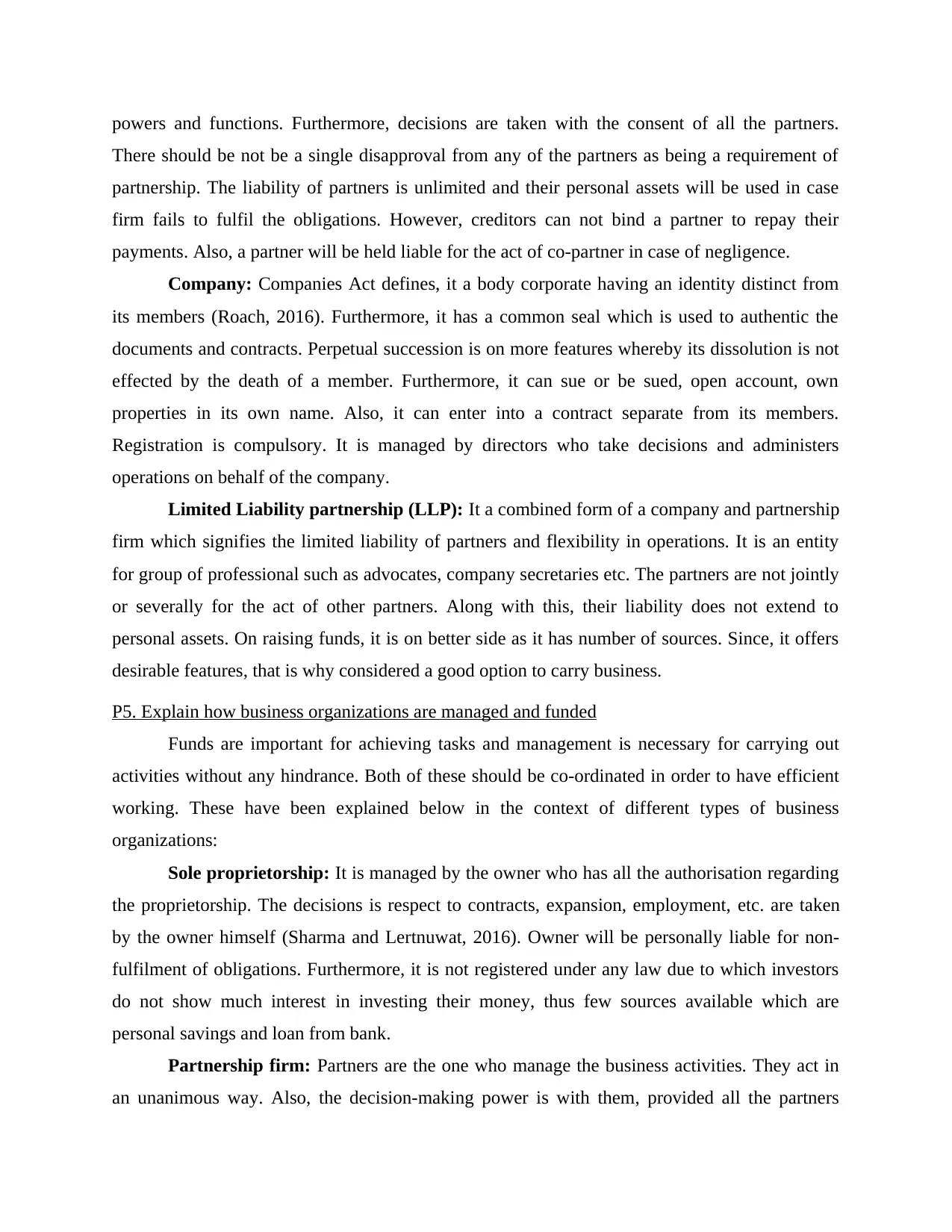
powers and functions. Furthermore, decisions are taken with the consent of all the partners.
There should be not be a single disapproval from any of the partners as being a requirement of
partnership. The liability of partners is unlimited and their personal assets will be used in case
firm fails to fulfil the obligations. However, creditors can not bind a partner to repay their
payments. Also, a partner will be held liable for the act of co-partner in case of negligence.
Company: Companies Act defines, it a body corporate having an identity distinct from
its members (Roach, 2016). Furthermore, it has a common seal which is used to authentic the
documents and contracts. Perpetual succession is on more features whereby its dissolution is not
effected by the death of a member. Furthermore, it can sue or be sued, open account, own
properties in its own name. Also, it can enter into a contract separate from its members.
Registration is compulsory. It is managed by directors who take decisions and administers
operations on behalf of the company.
Limited Liability partnership (LLP): It a combined form of a company and partnership
firm which signifies the limited liability of partners and flexibility in operations. It is an entity
for group of professional such as advocates, company secretaries etc. The partners are not jointly
or severally for the act of other partners. Along with this, their liability does not extend to
personal assets. On raising funds, it is on better side as it has number of sources. Since, it offers
desirable features, that is why considered a good option to carry business.
P5. Explain how business organizations are managed and funded
Funds are important for achieving tasks and management is necessary for carrying out
activities without any hindrance. Both of these should be co-ordinated in order to have efficient
working. These have been explained below in the context of different types of business
organizations:
Sole proprietorship: It is managed by the owner who has all the authorisation regarding
the proprietorship. The decisions is respect to contracts, expansion, employment, etc. are taken
by the owner himself (Sharma and Lertnuwat, 2016). Owner will be personally liable for non-
fulfilment of obligations. Furthermore, it is not registered under any law due to which investors
do not show much interest in investing their money, thus few sources available which are
personal savings and loan from bank.
Partnership firm: Partners are the one who manage the business activities. They act in
an unanimous way. Also, the decision-making power is with them, provided all the partners
There should be not be a single disapproval from any of the partners as being a requirement of
partnership. The liability of partners is unlimited and their personal assets will be used in case
firm fails to fulfil the obligations. However, creditors can not bind a partner to repay their
payments. Also, a partner will be held liable for the act of co-partner in case of negligence.
Company: Companies Act defines, it a body corporate having an identity distinct from
its members (Roach, 2016). Furthermore, it has a common seal which is used to authentic the
documents and contracts. Perpetual succession is on more features whereby its dissolution is not
effected by the death of a member. Furthermore, it can sue or be sued, open account, own
properties in its own name. Also, it can enter into a contract separate from its members.
Registration is compulsory. It is managed by directors who take decisions and administers
operations on behalf of the company.
Limited Liability partnership (LLP): It a combined form of a company and partnership
firm which signifies the limited liability of partners and flexibility in operations. It is an entity
for group of professional such as advocates, company secretaries etc. The partners are not jointly
or severally for the act of other partners. Along with this, their liability does not extend to
personal assets. On raising funds, it is on better side as it has number of sources. Since, it offers
desirable features, that is why considered a good option to carry business.
P5. Explain how business organizations are managed and funded
Funds are important for achieving tasks and management is necessary for carrying out
activities without any hindrance. Both of these should be co-ordinated in order to have efficient
working. These have been explained below in the context of different types of business
organizations:
Sole proprietorship: It is managed by the owner who has all the authorisation regarding
the proprietorship. The decisions is respect to contracts, expansion, employment, etc. are taken
by the owner himself (Sharma and Lertnuwat, 2016). Owner will be personally liable for non-
fulfilment of obligations. Furthermore, it is not registered under any law due to which investors
do not show much interest in investing their money, thus few sources available which are
personal savings and loan from bank.
Partnership firm: Partners are the one who manage the business activities. They act in
an unanimous way. Also, the decision-making power is with them, provided all the partners
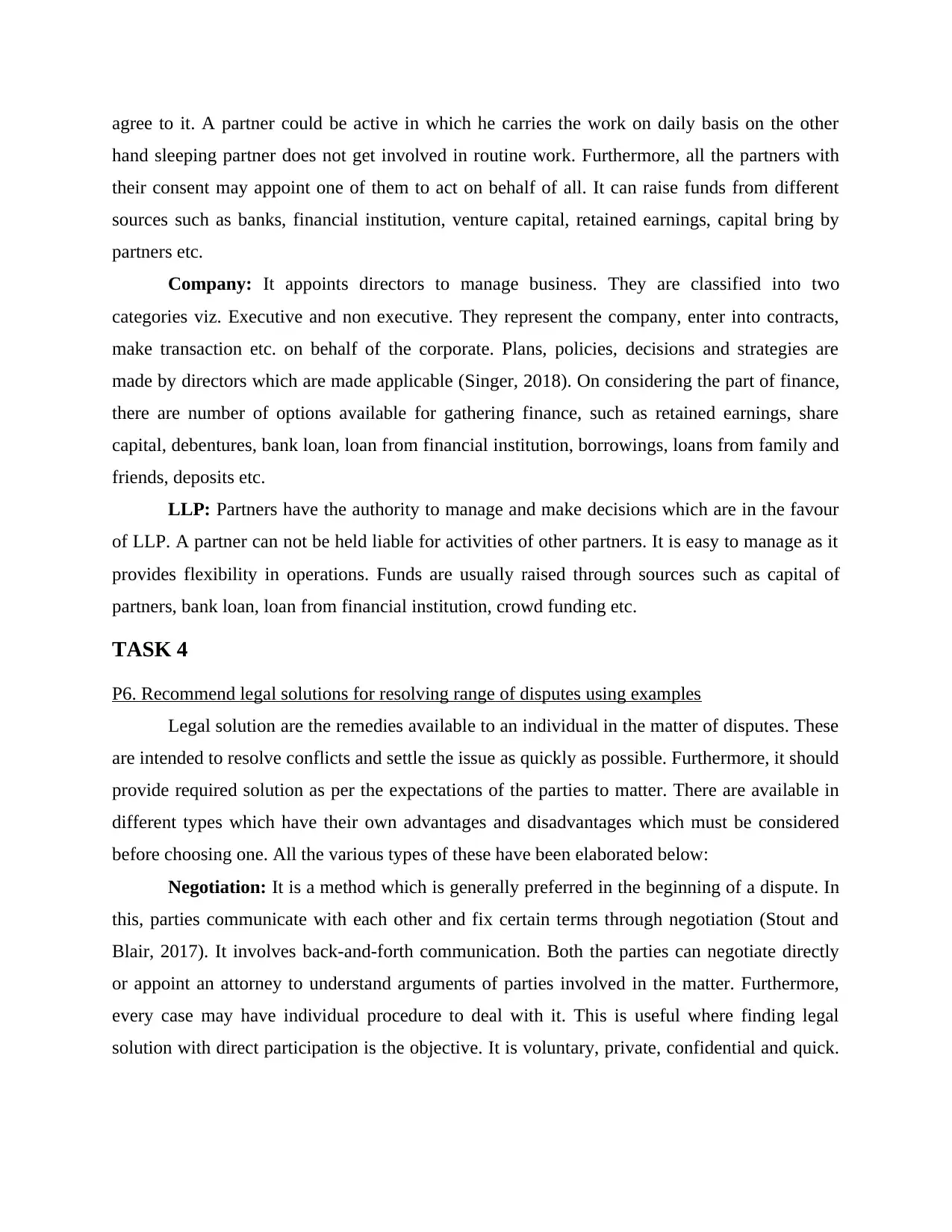
agree to it. A partner could be active in which he carries the work on daily basis on the other
hand sleeping partner does not get involved in routine work. Furthermore, all the partners with
their consent may appoint one of them to act on behalf of all. It can raise funds from different
sources such as banks, financial institution, venture capital, retained earnings, capital bring by
partners etc.
Company: It appoints directors to manage business. They are classified into two
categories viz. Executive and non executive. They represent the company, enter into contracts,
make transaction etc. on behalf of the corporate. Plans, policies, decisions and strategies are
made by directors which are made applicable (Singer, 2018). On considering the part of finance,
there are number of options available for gathering finance, such as retained earnings, share
capital, debentures, bank loan, loan from financial institution, borrowings, loans from family and
friends, deposits etc.
LLP: Partners have the authority to manage and make decisions which are in the favour
of LLP. A partner can not be held liable for activities of other partners. It is easy to manage as it
provides flexibility in operations. Funds are usually raised through sources such as capital of
partners, bank loan, loan from financial institution, crowd funding etc.
TASK 4
P6. Recommend legal solutions for resolving range of disputes using examples
Legal solution are the remedies available to an individual in the matter of disputes. These
are intended to resolve conflicts and settle the issue as quickly as possible. Furthermore, it should
provide required solution as per the expectations of the parties to matter. There are available in
different types which have their own advantages and disadvantages which must be considered
before choosing one. All the various types of these have been elaborated below:
Negotiation: It is a method which is generally preferred in the beginning of a dispute. In
this, parties communicate with each other and fix certain terms through negotiation (Stout and
Blair, 2017). It involves back-and-forth communication. Both the parties can negotiate directly
or appoint an attorney to understand arguments of parties involved in the matter. Furthermore,
every case may have individual procedure to deal with it. This is useful where finding legal
solution with direct participation is the objective. It is voluntary, private, confidential and quick.
hand sleeping partner does not get involved in routine work. Furthermore, all the partners with
their consent may appoint one of them to act on behalf of all. It can raise funds from different
sources such as banks, financial institution, venture capital, retained earnings, capital bring by
partners etc.
Company: It appoints directors to manage business. They are classified into two
categories viz. Executive and non executive. They represent the company, enter into contracts,
make transaction etc. on behalf of the corporate. Plans, policies, decisions and strategies are
made by directors which are made applicable (Singer, 2018). On considering the part of finance,
there are number of options available for gathering finance, such as retained earnings, share
capital, debentures, bank loan, loan from financial institution, borrowings, loans from family and
friends, deposits etc.
LLP: Partners have the authority to manage and make decisions which are in the favour
of LLP. A partner can not be held liable for activities of other partners. It is easy to manage as it
provides flexibility in operations. Funds are usually raised through sources such as capital of
partners, bank loan, loan from financial institution, crowd funding etc.
TASK 4
P6. Recommend legal solutions for resolving range of disputes using examples
Legal solution are the remedies available to an individual in the matter of disputes. These
are intended to resolve conflicts and settle the issue as quickly as possible. Furthermore, it should
provide required solution as per the expectations of the parties to matter. There are available in
different types which have their own advantages and disadvantages which must be considered
before choosing one. All the various types of these have been elaborated below:
Negotiation: It is a method which is generally preferred in the beginning of a dispute. In
this, parties communicate with each other and fix certain terms through negotiation (Stout and
Blair, 2017). It involves back-and-forth communication. Both the parties can negotiate directly
or appoint an attorney to understand arguments of parties involved in the matter. Furthermore,
every case may have individual procedure to deal with it. This is useful where finding legal
solution with direct participation is the objective. It is voluntary, private, confidential and quick.
⊘ This is a preview!⊘
Do you want full access?
Subscribe today to unlock all pages.

Trusted by 1+ million students worldwide
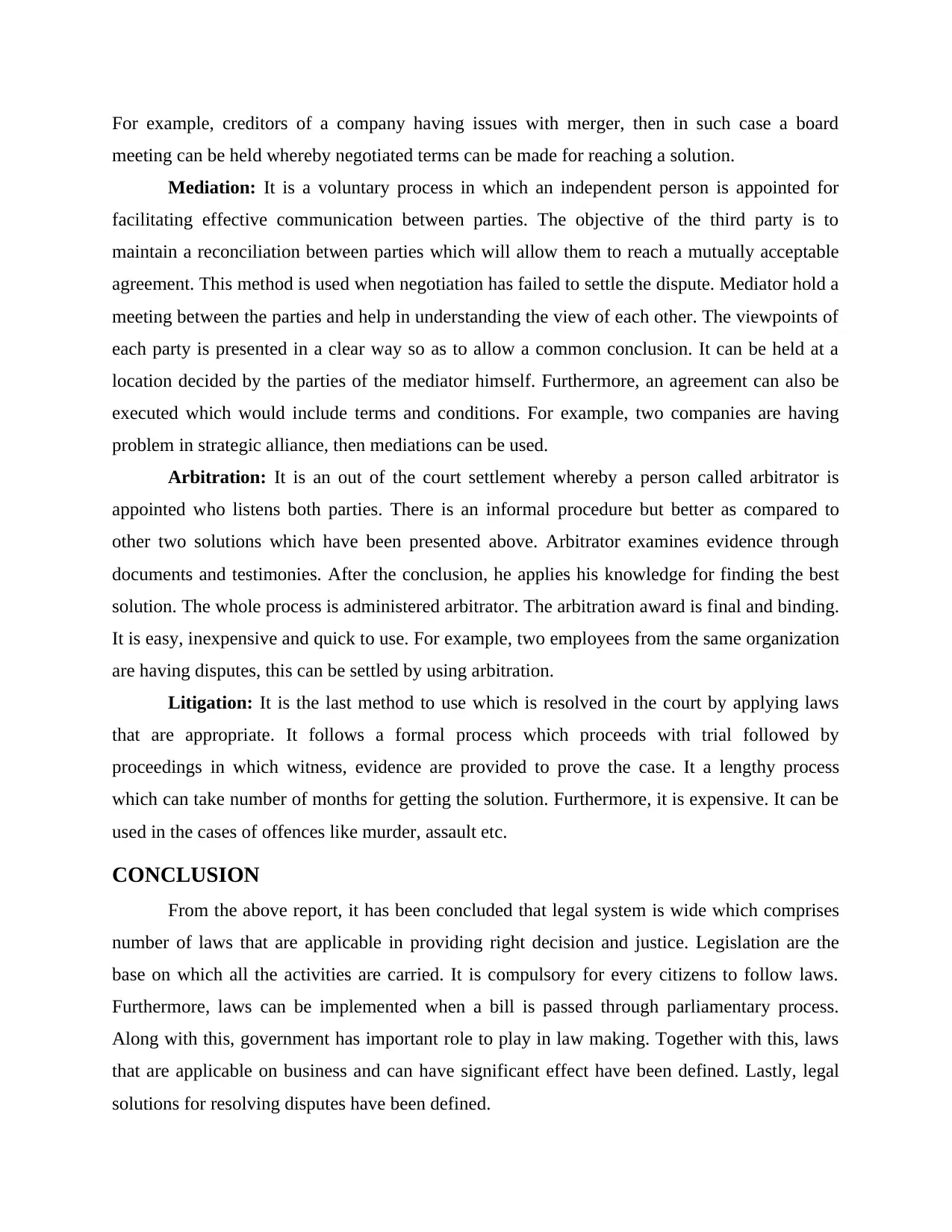
For example, creditors of a company having issues with merger, then in such case a board
meeting can be held whereby negotiated terms can be made for reaching a solution.
Mediation: It is a voluntary process in which an independent person is appointed for
facilitating effective communication between parties. The objective of the third party is to
maintain a reconciliation between parties which will allow them to reach a mutually acceptable
agreement. This method is used when negotiation has failed to settle the dispute. Mediator hold a
meeting between the parties and help in understanding the view of each other. The viewpoints of
each party is presented in a clear way so as to allow a common conclusion. It can be held at a
location decided by the parties of the mediator himself. Furthermore, an agreement can also be
executed which would include terms and conditions. For example, two companies are having
problem in strategic alliance, then mediations can be used.
Arbitration: It is an out of the court settlement whereby a person called arbitrator is
appointed who listens both parties. There is an informal procedure but better as compared to
other two solutions which have been presented above. Arbitrator examines evidence through
documents and testimonies. After the conclusion, he applies his knowledge for finding the best
solution. The whole process is administered arbitrator. The arbitration award is final and binding.
It is easy, inexpensive and quick to use. For example, two employees from the same organization
are having disputes, this can be settled by using arbitration.
Litigation: It is the last method to use which is resolved in the court by applying laws
that are appropriate. It follows a formal process which proceeds with trial followed by
proceedings in which witness, evidence are provided to prove the case. It a lengthy process
which can take number of months for getting the solution. Furthermore, it is expensive. It can be
used in the cases of offences like murder, assault etc.
CONCLUSION
From the above report, it has been concluded that legal system is wide which comprises
number of laws that are applicable in providing right decision and justice. Legislation are the
base on which all the activities are carried. It is compulsory for every citizens to follow laws.
Furthermore, laws can be implemented when a bill is passed through parliamentary process.
Along with this, government has important role to play in law making. Together with this, laws
that are applicable on business and can have significant effect have been defined. Lastly, legal
solutions for resolving disputes have been defined.
meeting can be held whereby negotiated terms can be made for reaching a solution.
Mediation: It is a voluntary process in which an independent person is appointed for
facilitating effective communication between parties. The objective of the third party is to
maintain a reconciliation between parties which will allow them to reach a mutually acceptable
agreement. This method is used when negotiation has failed to settle the dispute. Mediator hold a
meeting between the parties and help in understanding the view of each other. The viewpoints of
each party is presented in a clear way so as to allow a common conclusion. It can be held at a
location decided by the parties of the mediator himself. Furthermore, an agreement can also be
executed which would include terms and conditions. For example, two companies are having
problem in strategic alliance, then mediations can be used.
Arbitration: It is an out of the court settlement whereby a person called arbitrator is
appointed who listens both parties. There is an informal procedure but better as compared to
other two solutions which have been presented above. Arbitrator examines evidence through
documents and testimonies. After the conclusion, he applies his knowledge for finding the best
solution. The whole process is administered arbitrator. The arbitration award is final and binding.
It is easy, inexpensive and quick to use. For example, two employees from the same organization
are having disputes, this can be settled by using arbitration.
Litigation: It is the last method to use which is resolved in the court by applying laws
that are appropriate. It follows a formal process which proceeds with trial followed by
proceedings in which witness, evidence are provided to prove the case. It a lengthy process
which can take number of months for getting the solution. Furthermore, it is expensive. It can be
used in the cases of offences like murder, assault etc.
CONCLUSION
From the above report, it has been concluded that legal system is wide which comprises
number of laws that are applicable in providing right decision and justice. Legislation are the
base on which all the activities are carried. It is compulsory for every citizens to follow laws.
Furthermore, laws can be implemented when a bill is passed through parliamentary process.
Along with this, government has important role to play in law making. Together with this, laws
that are applicable on business and can have significant effect have been defined. Lastly, legal
solutions for resolving disputes have been defined.
Paraphrase This Document
Need a fresh take? Get an instant paraphrase of this document with our AI Paraphraser
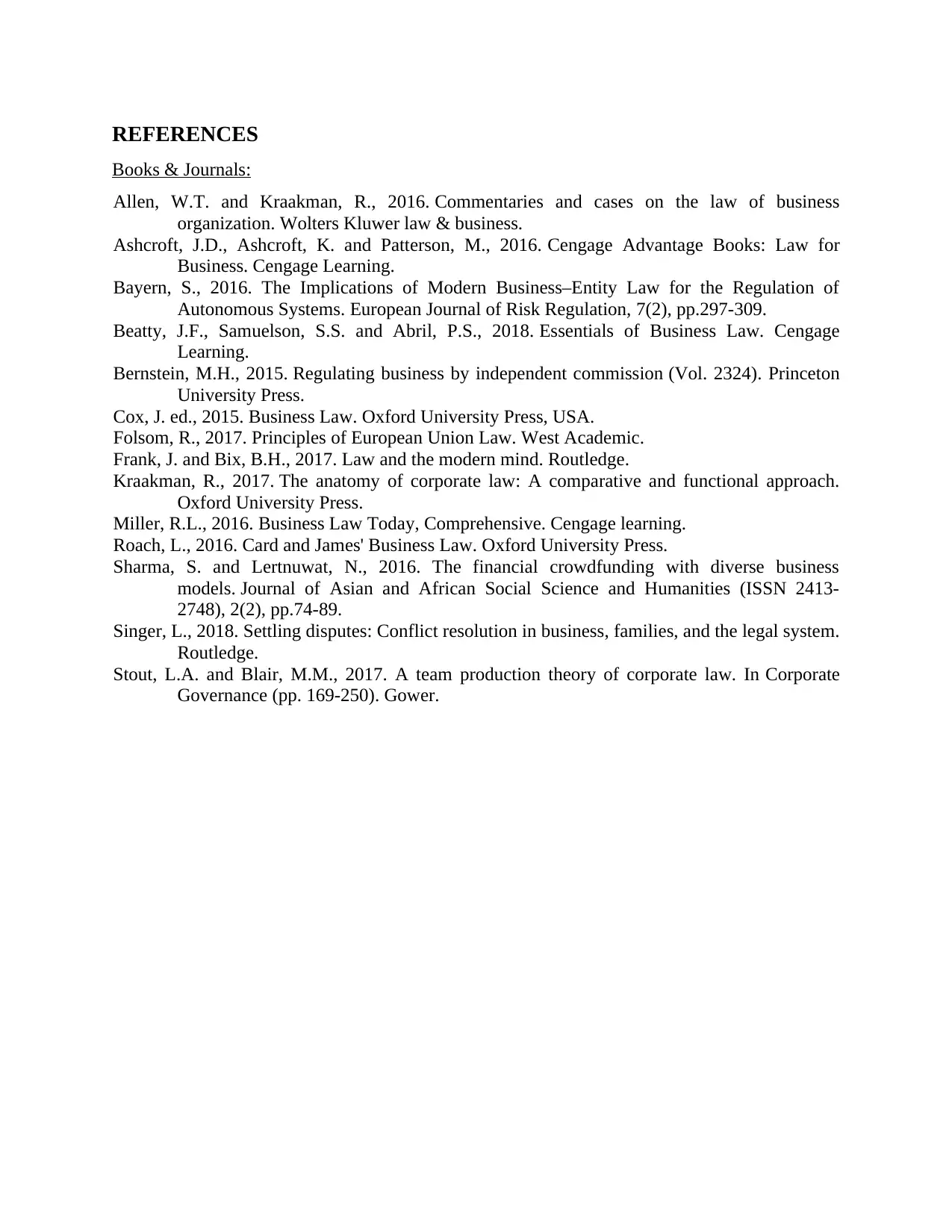
REFERENCES
Books & Journals:
Allen, W.T. and Kraakman, R., 2016. Commentaries and cases on the law of business
organization. Wolters Kluwer law & business.
Ashcroft, J.D., Ashcroft, K. and Patterson, M., 2016. Cengage Advantage Books: Law for
Business. Cengage Learning.
Bayern, S., 2016. The Implications of Modern Business–Entity Law for the Regulation of
Autonomous Systems. European Journal of Risk Regulation, 7(2), pp.297-309.
Beatty, J.F., Samuelson, S.S. and Abril, P.S., 2018. Essentials of Business Law. Cengage
Learning.
Bernstein, M.H., 2015. Regulating business by independent commission (Vol. 2324). Princeton
University Press.
Cox, J. ed., 2015. Business Law. Oxford University Press, USA.
Folsom, R., 2017. Principles of European Union Law. West Academic.
Frank, J. and Bix, B.H., 2017. Law and the modern mind. Routledge.
Kraakman, R., 2017. The anatomy of corporate law: A comparative and functional approach.
Oxford University Press.
Miller, R.L., 2016. Business Law Today, Comprehensive. Cengage learning.
Roach, L., 2016. Card and James' Business Law. Oxford University Press.
Sharma, S. and Lertnuwat, N., 2016. The financial crowdfunding with diverse business
models. Journal of Asian and African Social Science and Humanities (ISSN 2413-
2748), 2(2), pp.74-89.
Singer, L., 2018. Settling disputes: Conflict resolution in business, families, and the legal system.
Routledge.
Stout, L.A. and Blair, M.M., 2017. A team production theory of corporate law. In Corporate
Governance (pp. 169-250). Gower.
Books & Journals:
Allen, W.T. and Kraakman, R., 2016. Commentaries and cases on the law of business
organization. Wolters Kluwer law & business.
Ashcroft, J.D., Ashcroft, K. and Patterson, M., 2016. Cengage Advantage Books: Law for
Business. Cengage Learning.
Bayern, S., 2016. The Implications of Modern Business–Entity Law for the Regulation of
Autonomous Systems. European Journal of Risk Regulation, 7(2), pp.297-309.
Beatty, J.F., Samuelson, S.S. and Abril, P.S., 2018. Essentials of Business Law. Cengage
Learning.
Bernstein, M.H., 2015. Regulating business by independent commission (Vol. 2324). Princeton
University Press.
Cox, J. ed., 2015. Business Law. Oxford University Press, USA.
Folsom, R., 2017. Principles of European Union Law. West Academic.
Frank, J. and Bix, B.H., 2017. Law and the modern mind. Routledge.
Kraakman, R., 2017. The anatomy of corporate law: A comparative and functional approach.
Oxford University Press.
Miller, R.L., 2016. Business Law Today, Comprehensive. Cengage learning.
Roach, L., 2016. Card and James' Business Law. Oxford University Press.
Sharma, S. and Lertnuwat, N., 2016. The financial crowdfunding with diverse business
models. Journal of Asian and African Social Science and Humanities (ISSN 2413-
2748), 2(2), pp.74-89.
Singer, L., 2018. Settling disputes: Conflict resolution in business, families, and the legal system.
Routledge.
Stout, L.A. and Blair, M.M., 2017. A team production theory of corporate law. In Corporate
Governance (pp. 169-250). Gower.

⊘ This is a preview!⊘
Do you want full access?
Subscribe today to unlock all pages.

Trusted by 1+ million students worldwide
1 out of 14
Related Documents
Your All-in-One AI-Powered Toolkit for Academic Success.
+13062052269
info@desklib.com
Available 24*7 on WhatsApp / Email
![[object Object]](/_next/static/media/star-bottom.7253800d.svg)
Unlock your academic potential
Copyright © 2020–2025 A2Z Services. All Rights Reserved. Developed and managed by ZUCOL.





